
SpaceX performs key test on Starship rocket before third flight
What's the story
SpaceX is planning the third test flight for its colossal Starship rocket. Starship is currently the world's most powerful rocket. It's made up of a first-stage Super Heavy booster and a 165-foot tall upper-stage spacecraft, also called Starship. In the latest, the Elon Musk-led company successfully performed a "static fire test" for the rocket's upper-stage prototype, called Ship 28. The test involved igniting the six Raptor engines while the vehicle remained anchored at SpaceX's Starbase site in South Texas.
Twitter Post
Take a look at SpaceX's post
Flight 3 Starship completed a full-duration static fire with all six of its Raptor engines pic.twitter.com/Mxn8faKcEv
— SpaceX (@SpaceX) December 20, 2023
Details
Ship 28 completes full-duration static fire test
Both Starship's first stage and upper stage are powered by SpaceX's next-generation Raptor engines. Super Heavy is equipped with 33 Raptors while Starship gets six. SpaceX announced that "Flight 3 Starship completed a full-duration static fire with all six of its Raptor engines." Recently, a spin prime test was performed on the second stage of Starship, and that went well. The test confirmed that pumps can inject fuel and oxidizer into the engines.
Insights
Booster 10 prepared for upcoming test flight
Accompanying Ship 28 on the upcoming test flight will be Booster 10, the Super Heavy prototype. The booster has been placed on the orbital launch mount at the Starbase facility in South Texas and is expected to undergo its own static fire test soon. Once these tests are complete, the Starship upper stage will likely be stacked on top of the booster to finalize the launch vehicle.
Previous
Previous Starship test flights have ended in explosion
So far, Starship has flown twice. The first test flight happened in April followed by the second in November. Both missions aimed to send the rocket's upper stage halfway around Earth, with a splashdown in the Pacific Ocean near Hawaii. However, neither flight reached that goal. The April flight ended four minutes after lift-off due to issues including stage separation failure, ultimately leading to a controlled detonation. The second test flight was more successful but ended in an explosion.
Facts
Regulatory roadblocks ahead of the third test
SpaceX is still waiting for regulatory approval from the Federal Aviation Administration (FAA) for the third Starship launch. The FAA, which issues launch licenses, is investigating the November mishap. The agency will grant a license only after the inquiry is finished and SpaceX has implemented necessary corrective actions, if any. Musk previously said the third Starship vehicle should be ready to fly by the end of 2023.